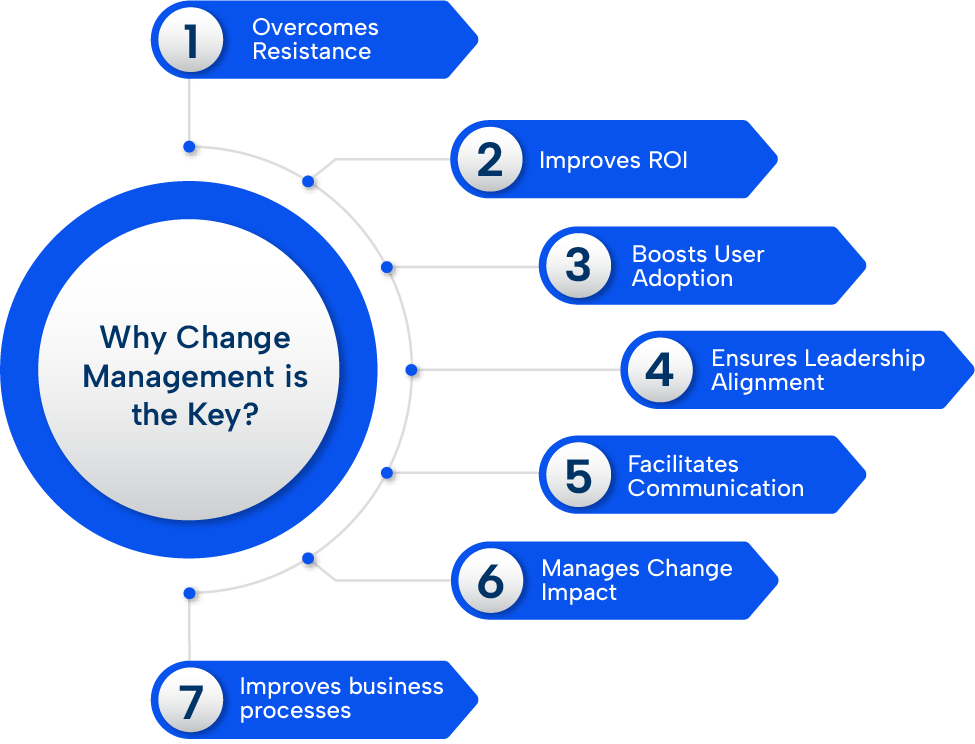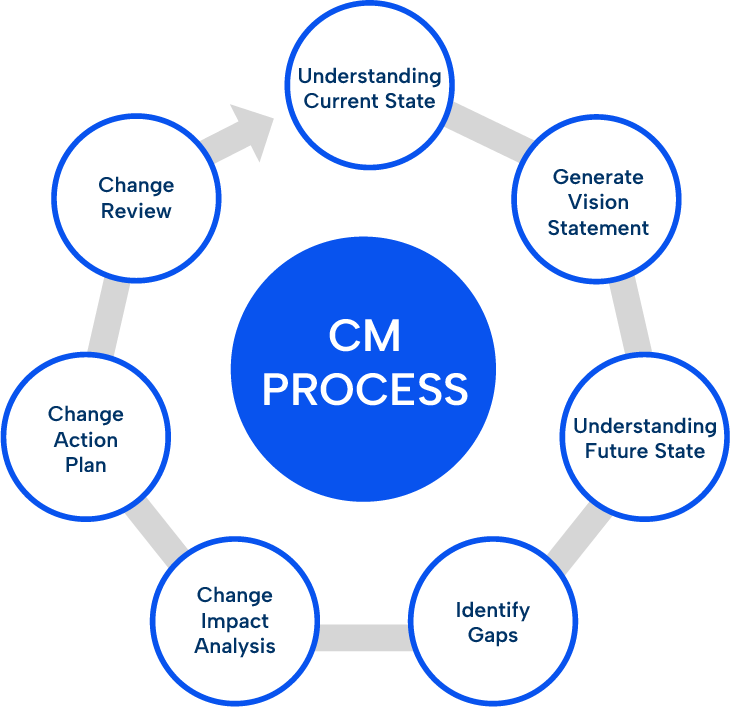Change Management — that’s the first thing that should come to your mind if you’re implementing any business enablement technologies. And here’s why.
Would you be shocked if you somehow found out that a staggering 70% of technological transformations don’t succeed?
That’s not all. While the value of global CRM market size continues to grow, as does the global ERP market value, nearly 75% of transformations never achieve the expected results.
So, the obvious question is: WHY?
Why are so many technological implementations unsuccessful?
One study shows that most technological change initiatives do not meet their goals mainly because of employee resistance and lack of management support. Another research suggests that the problems to successful CRM implementation were mainly people-related or linked to user adoption.
Of all the variables that determine the success of digital transformations, the statistics seem to point towards the people or the employees, who are the end-users of business technologies whether that’s CRM, ERP, HRM or other cutting-edge technologies.
But what is it about the people that determines the success or failure of digital transformations?
In a recent survey, over three-fourth of senior executives said that the biggest challenge they faced when implementing a new CRM system was getting their subordinates to use the system. Since there is little employee buy-in, it seems that businesses are struggling to meet the optimum ROI on these transformation projects even when they go live with the most advanced, AI-based systems.
Apart from the people, technological change goes wrong because some decision makers falsely assume the readiness of their organisation and employees for the adoption of new technology. They then end up communicating too little about the goals, impacts, skills gap and benefits, which fuels resistance from the employees as well as lack of ownership from the management.
In other cases, senior executives are under so much pressure that they unwittingly implement the technology first and keep the communication and training part at the end of the project, which hinders the end-user adoption rate.
And, precisely due to that reason, steering a business through a technological change is much more than just identifying and re-designing processes, hiring the best technology consultants and implementing a new system; it is also about ensuring end-user adoption of the new technology through carefully planned communication, management support, process integration and institutionalisation of the new system.
This is where the concept of change management comes in. As organisation leaders have come to realise that technological initiatives often require effective strategies for managing communication, increasing end-user adoption and improved ROI, they have started to adopt a proactive change management approach to guide their employees from the old state-of-affairs to a new one.
Studies also provide similar clues. Companies that successfully implemented technology have reported good change management as one of the primary reasons for success. Even when it comes to ROI, statistics clearly indicate that when there was excellent change management, the ROI of a technological project was 143%, and 35% with poor or no change management.
For a clear overview on why change management is the key to all technological transformations, here is a quick breakdown:

1. Overcomes Resistance
Almost all change initiatives are met with internal resistance at the beginning. That is particularly true when stakeholders don’t correctly perceive the benefits of any new system or are not fully clear about how their roles and responsibilities will change.
For instance, automation of processes can lead to operational efficiency but the people who performed those roles previously might feel obsolete or replaced. In other cases, employees may get utterly confused and frustrated with their new roles due to lack of organisational support during the change. These circumstances ultimately fuel internal resistance and greatly hinder end-user adoption.
To overcome this resistance, change management teams analyse employees based on their behaviour, openness to change and learning abilities and categorise them into different groups so that separate engagement activities and plans can be tailored for each group.
Top adopters of new technology may be allowed to rapidly transition and set a benchmark for other groups. These top adopters can also advocate and encourage their peers on behalf of the change managers to adopt and transition into the new systems.
2. Improves ROI

Another reason why change management is key for digital transformation is it improves the ROI for the new system, which is the ultimate goal of any financial investment that organisations make. By expediting the pace of change, optimal utilisation of resources and time, and allowing for a greater efficiency of processes, change management approach typically drives ROI up by several folds.
Industry statistics reveal that the average ROI for CRM is $8.71 for every dollar spent and when properly implemented, the ROI of a CRM system can exceed 245%.
Similarly, 95% of businesses have reported business process improvement after successfully implementing ERP systems. Others have experienced 40% reduction in IT costs, 38% reduction in inventory levels and 35% reduction in cycle time due to properly implemented ERP solutions.
3. Boosts User Adoption
Innovative technology and its proper implementation alone does not guarantee the success of a digital transformation.
In the aftermath of any technological shift, the end-users are the ones that are most affected by skills-gap and unfamiliarity with the new system. This creates an ambiguity about their new roles and responsibilities.
A proactive change management strategy minimises this ambiguity and boosts user adoption rate by preparing employees for the change right from the beginning and providing continuous support. Training sessions and workshops are scheduled at every step of the way prior to going live. Senior executives sit down with employees individually or in a group to get them onboard with the change and organisations facilitate ample time and opportunities for employees to grow into the new system.
4. Ensures Leadership Alignment
For all successful digital transformation within an organisation, a strong sponsorship from the top management is always crucial. Without the approval and support of the decision-makers, it is virtually impossible for mid-level managers to implement any changes. A proper change management plan ensures just that.
When change initiatives are backed by strong leadership, resources are easily managed, and employees remain highly motivated for the change. Active involvement of senior leaders through the change process in planning, communicating and gathering organisation-wide support for the change boosts the success rate of the new system once it goes live.
According to a study by Project Management Institute, the number one factor that determines the success of technological change initiatives happens to be strong sponsorship from the top management within organisations.
5. Facilitates Communication

Without effective and routine communication channels, it is very unlikely for organisations to thrive even in normal circumstances, let alone survive a technological shift. Despite having a standard communication channel, information can sometimes be unwittingly distorted or even ignored altogether. There can be times when critical messages and instructions are not generated and delivered on the right time to the right people simply because there was no separate communication plan for the change initiative.
Change management eliminates such gaps in communication by ensuring that there is a detailed communication plan for all stakeholders; key messages or instructions are prepared and ready to be delivered to the right people when needed; and critical information are accessible to everyone involved. Additionally, regular meetings among internal teams, external consultants and change management teams also ensure that everyone is up to date on the on-going developments and are aware of what is expected of them in terms of performance and compliance.
6. Manages Change Impact
Technological change management allows top management to develop a deeper understanding of just how much impact the new technology will have on the people and processes. Sometimes teams might have to be completely restructured to facilitate the change; other times, certain processes might be optimised and old systems could get phased out of operation. Then there are other stakeholders besides employees, like the senior executives themselves, including other departments and customers.
Change management process identifies such change impacts and prepares stakeholders at all levels to embrace them with open arms. By facilitating readiness activities, formulating Readiness Checklists and Trackers and planning for contingencies, the change management teams will ensure that new systems are deployed with as little roadblocks as possible, and further sustained without any issues.
7. Improves business processes
Technological change often involves continuous maintenance and improvement of business processes and system functions. A change management approach ensures that such improvements are planned and executed periodically, and all the associated stakeholders are timely informed, properly communicated and adequately prepared for the on-going changes.
Proper planning and execution of such continuous changes involves assessing and identifying the processes that need to change, managing resources and support systems, meeting the cost of change in terms of time and funds and fostering continued cooperation from the management as well as employees. At the end of it all, an effective technology adoption and change management strategy will result in a great improvement and efficiency in the overall business process.
And here’s why Dogma is an expert in managing technological change

Many times, you need is the guidance of professional technology consultants who after identifying your needs form a separate change management team, whose services are normally paid for. As experienced change partners and trusted advisors, here is how Dogma Group can help.
At Dogma, we focus sharply on driving sustainable change and boosting user adoption through active engagement of the people who will ultimately use the technology day-in and day-out as part of their jobs.
We work closely with your internal team to identify the impact of the project on various functions and processes, stakeholders and the end-users. From interviewing the people to reviewing necessary activities to support each stakeholder to adopt the change process, Dogma’s change management team, which is separate from the team of project consultants, are keen on driving your business through this process of technological transformation.
Ready to talk with the experts?
Our team of professional IT consultants will help you find the perfect solution for all your technological needs, including all your technology adoption and change management requirements. Just call us on 01296 328 689 or email us at info@dogmagroup.co.uk for a no-obligation consultation.

